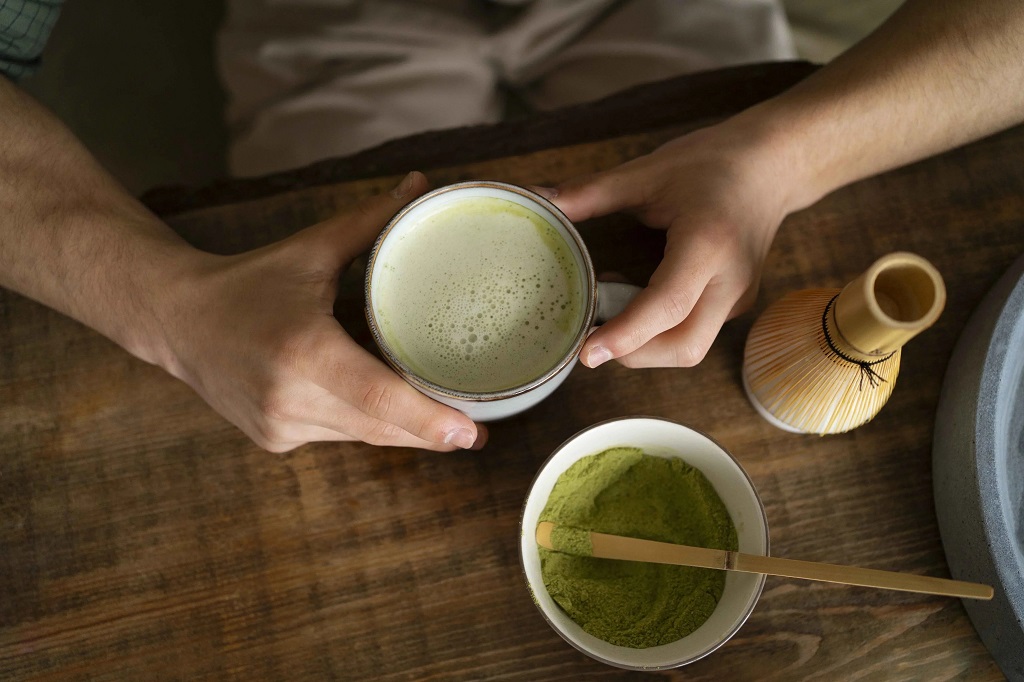
If you’ve ever taken a sip of matcha and thought, “Why does this taste like grass?”—you’re not alone. The vibrant green powder, now a global wellness staple, often surprises first-time drinkers with its bold, earthy, and yes, grassy taste. But here’s the twist: that unique flavor is actually a sign of quality, tradition, and health-packed goodness matcha taste grassy.
In this guide, we’ll break down why matcha tastes grassy, what influences its flavor, how to pick a better-tasting matcha, and whether you can (or should) try to change that taste. If you’re curious about matcha’s benefits, quality, and how to enjoy it, keep reading—this article is your complete flavor roadmap.
What Is Matcha?
Before diving into the flavor, let’s understand what matcha really is.
Matcha is a type of powdered green tea made from shade-grown tea leaves called tencha. Unlike regular green tea, where leaves are steeped and discarded, matcha involves consuming the entire leaf—which results in a more concentrated flavor and higher nutritional value.
Key Features of Matcha:
- Bright green color (from chlorophyll)
- Stone-ground powder (fine, silky texture)
- Consumed as a drink or in recipes (latte, smoothie, desserts)
Why Does Matcha Taste Grassy?
-
Shade-Grown Leaves Boost Chlorophyll
One of the main reasons matcha tastes grassy is due to chlorophyll—the green pigment plants use to convert sunlight into energy. During the last few weeks before harvest, matcha tea plants are shaded from the sun. This stress response causes them to produce more chlorophyll, which boosts both the vibrant color and the “green” taste.
Chlorophyll = Grassy Taste + Health Benefits
- Improves detoxification
- Enhances antioxidant levels
- Offers natural energy boost
-
High Levels of Amino Acids (Especially L-Theanine)
Premium matcha has high amounts of L-theanine, an amino acid that gives the tea a savory, umami undertone. The interaction of L-theanine with chlorophyll and catechins results in that signature grassy, sweet-bitter balance.
L-theanine contributes to:
- Calm focus
- Reduced stress
- Better flavor complexity
-
Catechins and Tannins
Catechins are natural antioxidants found in green tea. Matcha is rich in a specific one called EGCG (Epigallocatechin gallate), which is known for fighting inflammation and boosting metabolism. However, EGCG also contributes to bitterness—which, when combined with chlorophyll, enhances the vegetal, grassy profile.
Factors That Influence Matcha’s Grassy Taste

Not all matcha is created equal. Several variables affect the taste:
-
Grade of Matcha
There are three main grades:
- Ceremonial Grade: Highest quality, used in traditional tea ceremonies. Smooth, less bitter, slightly sweet, vibrant green color.
- Premium Grade: Great for daily drinking, good balance of taste and nutrition.
- Culinary Grade: Best for cooking and baking. Stronger grassy and bitter notes.
The lower the grade, the more likely the matcha will have a harsh, bitter, or overly grassy taste.
-
Harvest Time
- First Harvest (Ichibancha): Best flavor, richest in L-theanine.
- Second or Third Harvest: Less vibrant, more bitter and grassy.
-
Origin and Cultivation Practices
Matcha from Uji (Kyoto) or Nishio (Aichi Prefecture) in Japan is generally smoother and higher in quality. Japanese growers carefully monitor:
- Soil health
- Shading duration
- Stone grinding process
-
Storage Conditions
Matcha is sensitive to:
- Light
- Heat
- Oxygen
Poorly stored matcha can oxidize, turning dull in color and grassy-bitter in taste. Always store in an airtight, cool, dark container.
Can You Make Matcha Taste Less Grassy?
Yes! If the taste is too grassy or bitter for your liking, there are simple ways to enhance or adjust it.
-
Choose a Higher Grade
Always opt for ceremonial or premium grade matcha for drinking. It’s less grassy and more balanced.
-
Proper Preparation Techniques
- Water Temperature: Never use boiling water! Ideal range: 70°C – 80°C (160°F – 175°F)
- Whisking: Use a bamboo whisk (chasen) to create a creamy froth. This reduces bitterness.
- Sifting: Sift matcha before use to remove clumps and improve smoothness.
-
Add Natural Sweeteners or Milk
- Use honey, maple syrup, or vanilla to tone down grassiness.
- Try it with almond, oat, or dairy milk for a matcha latte with a mellow taste.
Matcha Flavor: Acquired or Appreciated?
It’s true that some people never warm up to the grassy notes in matcha. But for others, it becomes a cherished part of their daily routine. The umami, the earthiness, and even the subtle bitterness represent purity and wellness.
Think of matcha like dark chocolate or black coffee—complex, intense, and worth understanding.
Read More Also: Unveiling Nature’s Secret: A Four-Ingredient Mounjaro Inspired Elixir
FAQs About Matcha’s Grassy Taste
Is matcha supposed to taste grassy?
Yes. The grassy taste comes from natural compounds like chlorophyll, catechins, and amino acids. It’s normal and often indicates good quality.
Does grassy matcha mean it’s low quality?
Not necessarily. A mild grassy note is natural, but overwhelming bitterness and dull color often indicate lower quality or poor storage.
Why does my matcha taste bitter and not just grassy?
Likely causes:
- Too hot water
- Low-grade matcha
- Improper preparation
Try lowering your water temp and switching to a ceremonial-grade matcha.
How do I make matcha taste better?
- Use less powder
- Mix with milk (matcha latte)
- Add natural sweeteners
- Follow the right brewing method
Is grassy matcha still healthy?
Absolutely! The grassy taste comes from compounds like chlorophyll and catechins, which are key to matcha’s detoxifying, antioxidant, and energy-boosting properties.
Final Thoughts: Embrace the Green Goodness
Matcha’s grassy flavor is more than a taste—it’s a symbol of nature, health, and mindfulness. While it might be surprising at first, it’s part of what makes matcha such a unique and powerful superfood.
Whether you’re sipping a frothy bowl of ceremonial matcha or adding it to your morning smoothie, understanding the source of its flavor helps you appreciate the experience even more.
Ready to Upgrade Your Matcha Game?
Explore premium ceremonial-grade matcha and learn the art of making it the right way. Whether you’re a newbie or a tea lover, embracing the natural flavor is your first step to mastering the matcha ritual.
👉 Start your matcha journey today. Taste the tradition. Feel the energy. Live green.




